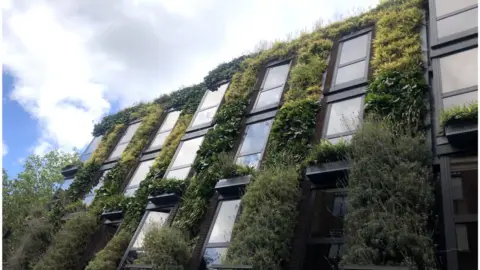How to keep your cool when the office heats up
 Christine Ro
Christine RoI mostly love working from home in East London, with its generally mild weather.
The exception is when the temperature rises suddenly, and my 16th-floor flat starts to feel like a baking, heat-trap.
As the sun changes position, my workstation has to migrate too: I'll start near a west-facing window in the morning, and gradually make my way toward the east-facing kitchen, propping up my laptop on makeshift stands.
During heatwaves, I'm nearly useless between the hours of about 15.00 and 18.00.
- If I need to work during this period, low-concentration, routine tasks are about all I can handle.
I'm actually one of the lucky ones. When it comes to the toll of high temperatures, (which are intensifying due to human-induced climate change), much of the focus is on the elderly, younger outdoor workers, or the vulnerable unhoused.
As for indoor jobs, people who do physically taxing work, under time pressure, for instance in factories and warehouses, are much more likely to feel the heat than a laptop jockey like me.
From call-centre workers to industrial bakers, productivity lags and health risks accumulate for many employees in indoor environments during spells of hot weather.
This hurts their employers and the broader economies as well. For example, one estimate is that by 2100, losses to the urban economy due to increased heating could reach 9.5% in Bilbao, Spain.


No one is immune: in London, the financial services, public administration and retail sectors are especially exposed to productivity losses due to high heat.
It's not only paid workers who are affected. A study in the US suggested that students' exam results are poorer in hotter years.
Some people may actually think that they're helping by continuing to work in the same way during periods of oppressive heat.
Together with colleagues, Anna Mavrogianni, who researches sustainable building and urban design at University College London, has investigated London care homes, where there's a mismatch between thermal comfort levels of elderly residents and younger workers.
"In some ways they were sacrificing; they were happy to work in these uncomfortable conditions because it was perceived as beneficial to the occupants," says Dr Mavrogianni.
But these perceptions, while well-meaning, can be harmful, she says, not just to workers moving around frequently, but also to the people they are looking after - older people with health conditions that make it hard to gauge just how hot it is.
Some common-sense measures can help reduce the risks of overheating. One useful example is easing restrictive uniform requirements and dress codes for workers during hot weather.
In Japan, where dress codes can be very strict, the Cool Biz Campaign encourages looser attitudes toward workplace clothing in summer.
 Christine Ro
Christine RoDr Mavrogianni advises building managers to switch off any equipment that's not in use, like photocopiers, as it all contributes to internal heat.
"Surprisingly, it can make a lot of difference," she says.
It's also important for individuals to be able to manage their local environments, Dr Mavrogianni stresses.
Being able to open the closest windows or to manage temperature settings can hugely improve an indoor worker's thermal comfort. "People tend to be more tolerant of warm conditions if they're able to adjust their environment."
Thankfully, for the many people who have shifted to remote work during the Covid-19 pandemic, flexibility in working hours may allow them to orient their days not only around their personal lives, but also around their environmental conditions.
Along with flexible working hours, malleable building design can help to keep indoor workers healthy. In offices, workstations that are pushed up against windows could be moved away from sources of heat during the summer.
While air conditioning is necessary in some places, it shouldn't be the default everywhere. As energy-hungry air conditioners worsen climate change and will strain electricity systems in some places, climate experts promote more passive cooling options to improve ventilation.
Building stock should be better prepared to respond to heat stress overall.
Buildings in the UK, Dr Mavrogianni says, were designed to keep heat trapped in buildings. Thus, much more heat resilience needs to be incorporated.
Dr Mavrogianni comments that external shades tend to be more effective at cooling than internal shades (although they won't be affordable or feasible for all).
In addition, transitional spaces, like shaded courtyards and atria, can acclimatise people to temperature differences between indoors and outdoors.
Remote workers shouldn't be overlooked, given the expansion of home-based work during the Covid-19 pandemic.
"I think there should definitely be some form of support for assessment for someone's home working environment," Dr Mavrogianni says.
For example, companies may be able to negotiate group discounts with energy companies for the renewable energy that powers their home workers' cooling devices.
Companies could also support the installation of low-flow and highly efficient appliances for remote workers in drought-stressed locations.
Empty office buildings with powerful cooling systems could also be repurposed during heatwaves, so that people can use them as cooling centres.
 Greenteg
GreentegCertain devices, like thermometers and humidity meters, could help as well.
Having a thermometer on every workstation, Dr Mavrogianni says, would mean that "people could flag up if there are any issues. They would have the evidence to go back to their manager and say, 'Look, there's a problem that needs to be addressed.'"
Poor insulation can become an occupational health issue for home-based workers, in complex ways. Cheryl Holder, who teaches medicine at Florida International University, gives the example of a patient with chronic obstructive pulmonary disease (COPD), who was facing high energy bills.
"She didn't even realise that the heat was worsening her COPD," Holder explains.
"Her house also had a lot of leakage, because poor people also live in poor housing. So when she did run her little air conditioner, the bill went higher, because half of it went through the poor insulation and all the leaks," says Holder.
"So there's so many factors, and she didn't quite connect the dots. But she just knew she couldn't pay her bills," she adds.
Supporting home improvements and the landscaping around offices can improve the heat resilience of buildings and the people who live and work in them.
 Christine Ro
Christine RoIn humid Karachi, Pakistan, where a devastating heatwave directly caused at least 1,300 deaths in 2015, new housing lacks cross-ventilation. And the city as a whole lacks green space.
Installing insulating materials could be a useful employment opportunity to many builders in Karachi.
The opportunities extend further - into larger-scale urban design. The UK's Office of National Statistics estimates that in 2018, urban woodlands in 11 city regions saved £229 million in labour productivity, not to mention savings on air conditioning.
Ultimately, Dr Holder calls for a change in mindset among employers and policymakers, which would protect workers and the environment simultaneously: "When I protect my worker, it will protect all of us".
